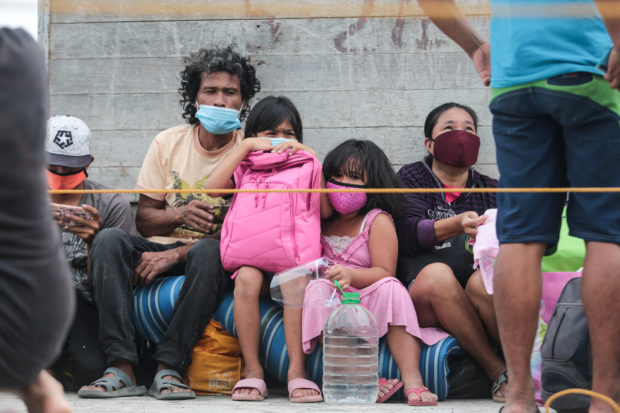
Residents of Barangay Padang in Legazpi City, Albay start to evacuate in preparation for Typhoon Rolly. This photo was taken on Saturday, Oct. 31, 2020, (Photo by MARK ALVIC ESPLANA / Inquirer Southern Luzon)
MANILA, Philippines — The national government has P3.622 billion in calamity funds, some of which may be used to help those affected by Super Typhoon Rolly, Budget Secretary Wendel Avisado assured President Rodrigo Duterte in a high-level briefing on Monday.
Avisado explained that the money was the remainder of the budget of the National Disaster Risk Reduction Management Office (NDRRMO) — originally amounting to a P16-billion in calamity fund and later augmented with P5 billion under the Bayanihan to Recover as One Act, or Bayanihan 2.
Bayanihan 2 was intended as a stimulus fund for the country as it battles the COVID-19 pandemic.
Avisado noted that a lot of people had been asking if the government had money to deal with the latest calamity.
Duterte praised him for being “transparent” by revealing how much was left of the calamity fund. It was important for people to know that there was money for them and that it would be used properly.
He then expressed confidence that the people would understand that the government “stretching to the limit” its money, considering that it was also fighting the COVID-19 pandemic.
“We have been transparent, that’s good[…] for as long as we spend it for the purpose which it was intended to be appropriated,” Duterte added.
Super Typhoon Rolly, which battered the Bicol Region and Southern Luzon over the weekend, was not the first natural calamity to strike the Philippines recently. Late into 2019, a series of earthquakes rocked Mindanao. Then last Jan. 13, Taal Volcano erupted, affecting thousands of residents, farmlands, and tourism establishments.
In light of these events, some lawmakers questioned why the calamity fund had been cut down, pointing out that the Philippines had long been vulnerable to natural disasters, particularly typhoons and earthquakes due to its being in the Pacific ring of fire.
Rolly is not also the first destructive weather disturbance to hit the country. In October, Bicol and other parts of Luzon also endured Tropical Depression Ofel, shortly followed by Tropical Storm Pepito that moved across Aurora and the rest of Central Luzon.
Then Typhoon Quinta barreled through Southern Luzon, again affecting Bicol, days before Rolly entered the Philippine area of responsibility.
[atm]